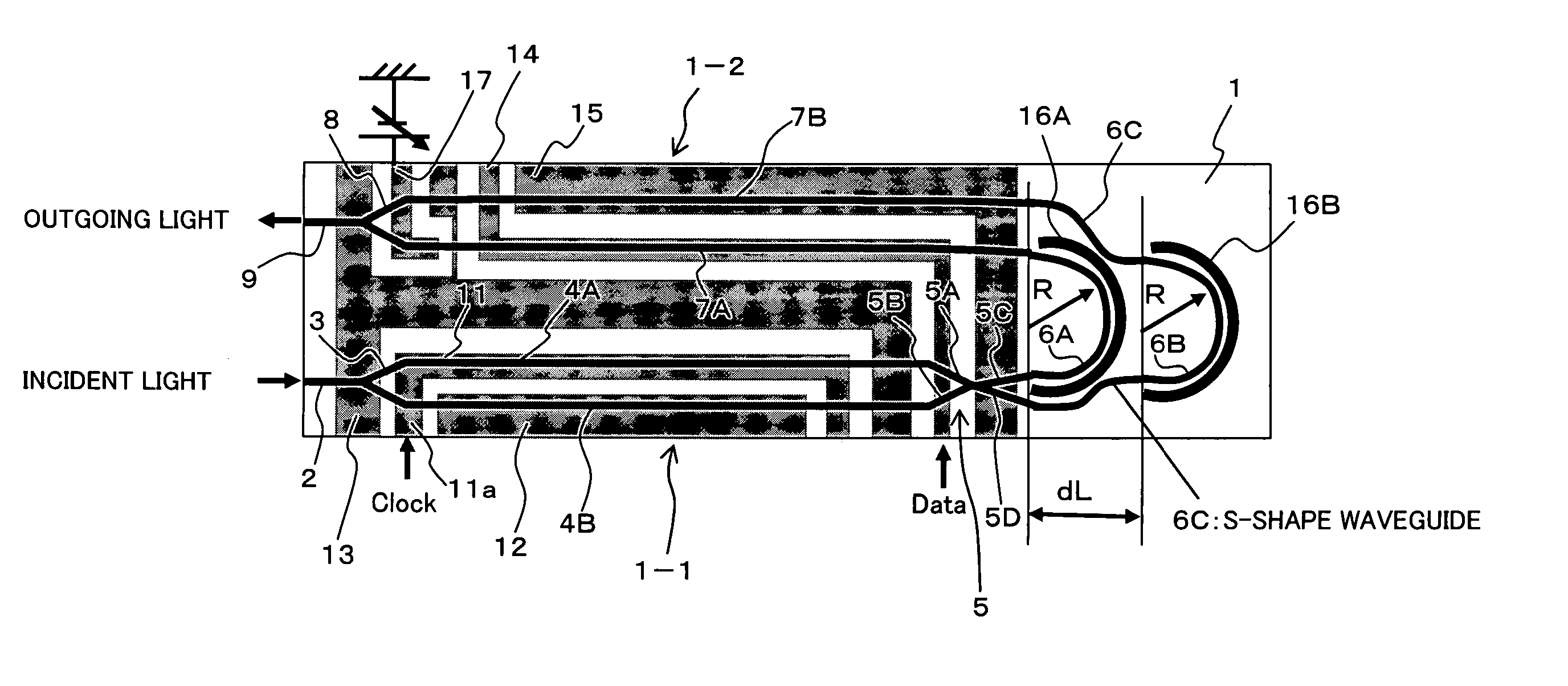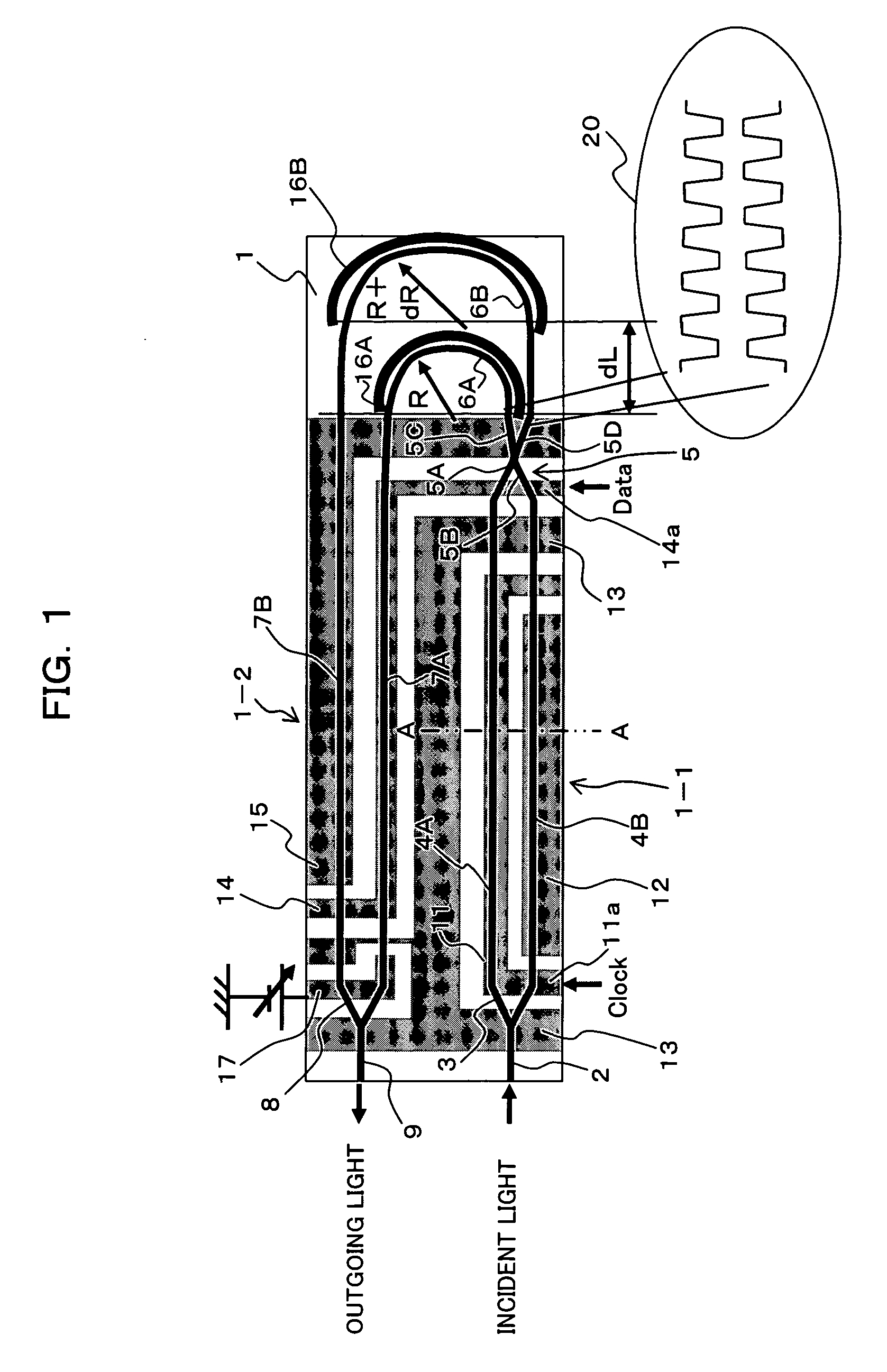Optical communication device and optical device
a communication device and optical technology, applied in the field of optical communication devices and optical devices, can solve the problems of increased light insertion loss and limit in the reduction of drive voltage, and achieve the effect of reducing insertion loss
- Summary
- Abstract
- Description
- Claims
- Application Information
AI Technical Summary
Benefits of technology
Problems solved by technology
Method used
Image
Examples
first modification
(A1) First Modification
[0071] In the RZ optical modulator shown in FIG. 1, the DC bias electrode 17 is arranged in the Y branching waveguide 8 of the post-stage NRZ modulator 1-2. However, when the DC bias electrode 17 is arranged in the Y branching waveguide 8, it is necessary to shorten the lengths of the electrodes 14 and 15 which overlap the parallel waveguides 7A and 7B, and the drive voltage is increased. Therefore, as shown in FIG. 2, the lengths of the electrodes 14 and 15 can be secured (maintained) as long as possible by arranging the DC bias electrode 17 on the bending waveguide 6B while the DC bias electrode 17 is provided along the bending waveguide 6B. In FIG. 2, the constituent indicated by the same numeral represents the identical or similar constituent described above.
second modification
(A2) Second Modification
[0072] In the structure shown in FIG. 1, when the difference in curvature radius dR between the bending waveguides 6A and 6B is large, the difference in light intensity between the two light is increased in the post-stage data modulator 1-2, and an extinction ratio of the light output is degraded. In order to prevent the degradation of the extinction ratio of the light output, it is desirable that the difference in curvature radius dR between the bending waveguides 6A and 6B is decreased as much as possible, e.g. the difference in curvature radius dR is set equal to or less than 100 μm. Therefore, as shown in FIG. 5, the curvature radiuses of the two bending waveguides 6A and 6B are set at (R) by inserting an S-shaped waveguide 6C having the larger curvature radius between the input and output portions (indicated by distance dL) of the bending waveguide 6B located on the outer periphery side. Accordingly, the extinction ratio having the same level as for the ...
third modification
(A3) Third Modification
[0073] In the configuration shown in FIG. 1, although the two outputs of the pre-stage clock modulator 1-1 are equal to each other in the output intensity, the chirps are inversed in the polarity. Because the two outputs of the pre-stage clock modulator 1-1 are multiplexed by the 2×2 coupler 5, distortion of the output waveform becomes troublesome in some cases. In the single-drive clock modulator 1-1 shown in FIG. 1, because magnitudes of the electric fields applied to the parallel waveguides 4A and 4B differ from each other as schematically shown in FIG. 7, the chirps inversed in the polarity are generated. FIG. 7 is a sectional view taken on line A-A of FIG. 1.
[0074] In order to avoid the inversed chirps, it is desirable that the amount of chirp generation is zero in the clock modulator 1-1. Therefore, as shown in FIG. 6, it is thought that the clock modulator 1-1 is formed in a dual drive configuration.
[0075] Namely, the signal electrodes 11A and 11B are...
PUM
| Property | Measurement | Unit |
|---|---|---|
| interaction length | aaaaa | aaaaa |
| distance | aaaaa | aaaaa |
| thickness | aaaaa | aaaaa |
Abstract
Description
Claims
Application Information
 Login to View More
Login to View More - R&D
- Intellectual Property
- Life Sciences
- Materials
- Tech Scout
- Unparalleled Data Quality
- Higher Quality Content
- 60% Fewer Hallucinations
Browse by: Latest US Patents, China's latest patents, Technical Efficacy Thesaurus, Application Domain, Technology Topic, Popular Technical Reports.
© 2025 PatSnap. All rights reserved.Legal|Privacy policy|Modern Slavery Act Transparency Statement|Sitemap|About US| Contact US: help@patsnap.com



